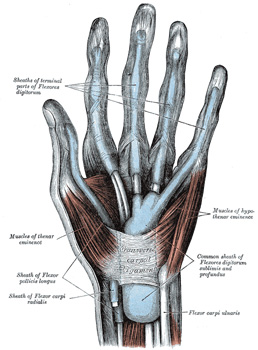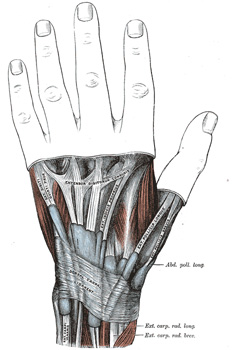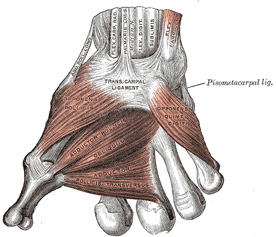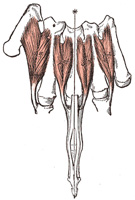| The muscles of the hand are subdivided into three groups: (1) those of the thumb, which occupy the radial side and produce the thenar eminence; (2) those of the little finger, which occupy the ulnar side and give rise to the hypothenar eminence; (3) those in the middle of the palm and between the metacarpal bones. | 1 |
| |
| Volar Carpal Ligament (ligamentum carpi volare).—The volar carpal ligament is the thickened band of antibrachial fascia which extends from the radius to the ulna over the Flexor tendons as they enter the wrist. | 2 |
| |
| Transverse Carpal Ligament (ligamentum carpi transversum; anterior annular ligament) (Figs. 421, 422).—The transverse carpal ligament is a strong, fibrous band, which arches over the carpus, converting the deep groove on the front of the carpal bones into a tunnel, through which the Flexor tendons of the digits and the median nerve pass. It is attached, medially, to the pisiform and the hamulus of the hamate bone; laterally, to the tuberosity of the navicular, and to the medial part of the volar surface and the ridge of the greater multangular. It is continuous, above, with the volar carpal ligament; and below, with the palmar aponeurosis. It is crossed by the ulnar vessels and nerve, and the cutaneous branches of the median and ulnar nerves. At its lateral end is the tendon of theFlexor carpi radialis, which lies in the groove on the greater multangular between the attachments of the ligament to the bone. On its volar surface the tendons of the Palmaris longus and Flexor carpi ulnaris are partly inserted; below, it gives origin to the short muscles of the thumb and little finger | 3 |
 |
FIG. 421– Transverse section across distal ends of radius and ulna. (See enlarged image) |
| |
 |
FIG. 422– Transverse section across the wrist and digits. (See enlarged image) |
| |
| |
| The Mucous Sheaths of the Tendons on the Front of the Wrist.—Two sheaths envelop the tendons as they pass beneath the transverse carpal ligament, one for the Flexores digitorum sublimis and profundus, the other for the Flexor pollicis longus (Fig. 423). They extend into the forearm for about 2.5 cm. above the transverse carpal ligament, and occasionally communicate with each other under the ligament. The sheath which surrounds the Flexores digitorum extends downward about half-way along the metacarpal bones, where it ends in blind diverticula around the tendons to the index, middle, and ring fingers. It is prolonged on the tendons to the little finger and usually communicates with the mucous sheath of these tendons. The sheath of the tendon of the Flexor pollicis longus is continued along the thumb as far as the insertion of the tendon. The mucous sheaths enveloping the terminal parts of the tendons of the Flexores digitorum have been described on page 449. | 4 |
 |
FIG. 423– The mucous sheaths of the tendons on the front of the wrist and digits. (See enlarged image) |
| |
| |
| Dorsal Carpal Ligament (ligamentum carpi dorsale; posterior annular ligament) (Figs. 421, 422).—The dorsal carpal ligament is a strong, fibrous band, extending obliquely downward and medialward across the back of the wrist, and consisting of part of the deep fascia of the back of the forearm, strengthened by the addition of some transverse fibers. It is attached, medially, to the styloid process of the ulna and to the triangular and pisiform bones; laterally, to the lateral margin of the radius; and, in its passage across the wrist, to the ridges on the dorsal surface of the radius. | 5 |
 |
FIG. 424– The mucous sheaths of the tendons on the back of the wrist. (See enlarged image) |
| |
| |
| The Mucous Sheaths of the Tendons on the Back of the Wrist.—Between the dorsal carpal ligament and the bones six compartments are formed for the passage of tendons, each compartment having a separate mucous sheath. One is found in each of the following positions (Fig. 424): (1) on the lateral side of the styloid process, for the tendons of the Abductor pollicis longus and Extensor pollicis brevis; (2) behind the styloid process, for the tendons of the Extensores carpi radialis longus and brevis; (3) about the middle of the dorsal surface of the radius, for the tendon of the Extensor pollicis longus; (4) to the medial side of the latter, for the tendons of the Extensor digitorum communis and Extensor indicis proprius; (5) opposite the interval between the radius and ulna, for the Extensor digiti quinti proprius; (6) between the head and styloid process of the ulna, for the tendon of the Extensor carpi ulnaris. The sheaths lining these compartments extends from above the dorsal carpal ligament; those for the tendons of Abductor pollicis longus, Extensor brevis pollicis, Extensores carpi radialis, and Extensor carpi ulnaris stop immediately proximal to the bases of the metacarpal bones, while the sheaths for Extensor communis digitorum, Extensor indicis proprius, and Extensor digiti quinti proprius are prolonged to the junction of the proximal and intermediate thirds of the metacarpus. | 6 |
 |
FIG. 425– The palmar aponeurosis. (See enlarged image) |
| |
| |
| Palmar Aponeurosis (aponeurosis palmaris; palmar fascia) (Fig. 425).—The palmar aponeurosis invests the muscles of the palm, and consists of central, lateral, and medial portions. | 7 |
| The central portion occupies the middle of the palm, is triangular in shape, and of great strength and thickness. Its apex is continuous with the lower margin of the transverse carpal ligament, and receives the expanded tendon of the Palmaris longus. Its base divides below into four slips, one for each finger. Each slip gives off superficial fibers to the skin of the palm and finger, those to the palm joining the skin at the furrow corresponding to the metacarpophalangeal articulations, and those to the fingers passing into the skin at the transverse fold at the bases of the fingers. The deeper part of each slip subdivides into two processes, which are inserted into the fibrous sheaths of the Flexor tendons. From the sides of these processes offsets are attached to the transverse metacarpal ligament. By this arrangement short channels are formed on the front of the heads of the metacarpal bones; through these the Flexor tendons pass. The intervals between the four slips transmit the digital vessels and nerves, and the tendons of the Lumbricales. At the points of division into the slips mentioned, numerous strong, transverse fasciculi bind the separate processes together. The central part of the palmar aponeurosis is intimately bound to the integument by dense fibroareolar tissue forming the superficial palmar fascia, and gives origin by its medial margin to the Palmaris brevis. It covers the superficial volar arch, the tendons of the Flexor muscles, and the branches of the median and ulnar nerves; and on either side it gives off a septum, which is continuous with the interosseous aponeurosis, and separates the intermediate from the collateral groups of muscles. | 8 |
| The lateral and medial portions of the palmar aponeurosis are thin, fibrous layers, which cover, on the radial side, the muscles of the ball of the thumb, and, on the ulnar side, the muscles of the little finger; they are continuous with the central portion and with the fascia on the dorsum of the hand. | 9 |
| The Superficial Transverse Ligament of the Fingers is a thin band of transverse fasciculi (Fig. 425); it stretches across the roots of the four fingers, and is closely attached to the skin of the clefts, and medially to the fifth metacarpal bone, forming a sort of rudimentary web. Beneath it the digital vessels and nerves pass to their destinations. | 10 |
| |
| 1. The Lateral Volar Muscles (Figs. 426, 427)
|
| Abductor pollicis brevis. |
|
Flexor pollicis brevis. |
| Opponens pollicis. |
|
Adductor pollicis (obliquus). |
| Adductor pollicis (transversus). |
|
| The Abductor pollicis brevis (Abductor pollicis) is a thin, flat muscle, placed immediately beneath the integument. It arises from the transverse carpal ligament, the tuberosity of the navicular, and the ridge of the greater multangular, frequently by two distinct slips. Running lateralward and downward, it is inserted by a thin, flat tendon into the radial side of the base of the first phalanx of the thumb and the capsule of the metacarpophalangeal articulation. | 11 |
| The Opponens pollicis is a small, triangular muscle, placed beneath the preceding. It arises from the ridge on the greater multangular and from the transverse carpal ligament, passes downward and lateralward, and is inserted into the whole length of the metacarpal bone of the thumb on its radial side. | 12 |
| The Flexor pollicis brevis consists of two portions, lateral and medial. The lateral and more superficial portion arises from the lower border of the transverse carpal ligament and the lower part of the ridge on the greater multangular bone; it passes along the radial side of the tendon of the Flexor pollicis longus, and, becoming tendinous, is inserted into the radial side of the base of the first phalanx of the thumb; in its tendon of insertion there is a sesamoid bone. The medial and deeper portion of the muscle is very small, and arises from the ulnar side of the first metacarpal bone between the Adductor pollicis (obliquus) and the lateral head of the first Interosseous dorsalis, and is inserted into the ulnar side of the base of the first phalanx with the Adductor pollicis (obliquus). The medial part of the Flexor brevis pollicis is sometimes described as the first Interosseous volaris. | 13 |
| The Adductor pollicis (obliquus) (Adductor obliquus pollicis) arises by several slips from the capitate bone, the bases of the second and third metacarpals, the intercarpal ligaments, and the sheath of the tendon of the Flexor carpi radialis. From this origin the greater number of fibers pass obliquely downward and converge to a tendon, which, uniting with the tendons of the medial portion of the Flexor pollicis brevis and the transverse part of the Adductor, is inserted into the ulnar side of the base of the first phalanx of the thumb, a sesamoid bone being present in the tendon. A considerable fasciculus, however, passes more obliquely beneath the tendon of the Flexor pollicis longus to join the lateral portion of the Flexor brevis and the Abductor pollicis brevis. | 14 |
 |
FIG. 426– The muscles of the thumb. (See enlarged image) |
| |
| The Adductor pollicis (transversus) (Adductor transversus pollicis) (Fig. 426) is the most deeply seated of this group of muscles. It is of a triangular form arising by a broad base from the lower two-thirds of the volar surface of the third metacarpal bone; the fibers converge, to be inserted with the medial part of the Flexor pollicis brevis and the Adductor pollicis (obliquus) into the ulnar side of the base of the first phalanx of the thumb. | 15 |
| |
| Variations.—The Abductor pollicis brevis is often divided into an outer and an inner part; accessory slips from the tendon of the Abductor pollicis longus or Palmaris longus, more rarely from the Extensor carpi radialis longus, from the styloid process or Opponens pollicis or from the skin over the thenar eminence. The deep head of the Flexor pollicis brevis may be absent or enlarged. The two adductors vary in their relative extent and in the closeness of their connection. The Adductor obliquus may receive a slip from the transverse metacarpal ligament. | 16 |
| |
| Nerves.—The Abductor brevis, Opponens, and lateral head of the Flexor pollicis brevis are supplied by the sixth and seventh cervical nerves through the median nerve; the medial head of the Flexor brevis, and the Adductor, by the eighth cervical through the ulnar nerve. | 17 |
| |
| Actions.—The Abductor pollicis brevis draws the thumb forward in a plane at right angles to that of the palm of the hand. The Adductor pollicis is the opponent of this muscle, and approximates the thumb to the palm. The Opponens pollicis flexes the metacarpal bone, i. e., draws it medialward over the palm; the Flexor pollicis brevis flexes and adducts the proximal phalanx. | 18 |
| |
| 2. The Medial Volar Muscles (Figs. 426, 427)
|
| Palmaris brevis. |
|
Flexor digiti quinti brevis. |
| Abductor digiti quinti. |
|
Opponens digiti quinti. |
|
| The Palmaris brevis is a thin, quadrilateral muscle, placed beneath the integument of the ulnar side of the hand. It arises by tendinous fasciculi from the transverse carpal ligament and palmar aponeurosis; the fleshy fibers are inserted into the skin on the ulnar border of the palm of the hand. | 19 |
 |
FIG. 427– The muscles of the left hand. Palmar surface. (See enlarged image) |
| |
| The Abductor digiti quinti (Abductor minimi digiti) is situated on the ulnar border of the palm of the hand. It arises from the pisiform bone and from the tendon of the Flexor carpi ulnaris, and ends in a flat tendon, which divides into two slips; one is inserted into the ulnar side of the base of the first phalanx of the little finger; the other into the ulnar border of the aponeurosis of the Extensor digiti quinti proprius. | 20 |
| The Flexor digiti quinti brevis (Flexor brevis minimi digiti) lies on the same plane as the preceding muscle, on its radial side. It arises from the convex surface of the hamulus of the hamate bone, and the volar surface of the transverse carpal ligament, and is inserted into the ulnar side of the base of the first phalanx of the little finger. It is separated from the Abductor, at its origin, by the deep branches of the ulnar artery and nerve. This muscle is sometimes wanting; the Abductor is then, usually, of large size. | 21 |
| The Opponens digiti quinti (Opponens minimi digiti) (Fig. 426) is of a triangular form, and placed immediately beneath the preceding muscles. It arises from the convexity of the hamulus of the hamate bone, and contiguous portion of the transverse carpal ligament; it is inserted into the whole length of the metacarpal bone of the little finger, along its ulnar margin. | 22 |
| |
| Variations.—The Palmaris brevis varies greatly in size. The Abductor digiti quinti may be divided into two or three slips or united with the Flexor digiti quinti brevis. Accessory head from the tendon of the Flexor carpi ulnaris, the transverse carpal ligament, the fascia of the forearm or the tendon of the Palmaris longus. A portion of the muscle may insert into the metacarpal, or separate slips the Pisimetacarpus, Pisiuncinatus or the Pisiannularis muscle may exist. | 23 |
| |
| Nerves.—All the muscles of this group are supplied by the eighth cervical nerve through the ulnar nerve. | 24 |
| |
| Actions.—The Abductor and Flexor digiti quinti brevis abduct the little finger from the ring finger and assist in flexing the proximal phalanx. The Opponens digiti quinti draws forward the fifth metacarpal bone, so as to deepen the hollow of the palm. The Palmaris brevis corrugates the skin on the ulnar side of the palm. | 25 |
| |
| 3. The Intermediate Muscles |
|
| The Lumbricales (Fig. 427) are four small fleshy fasciculi, associated with the tendons of the Flexor digitorum profundus. The first and second arise from the radial sides and volar surfaces of the tendons of the index and middle fingers respectively; the third, from the contiguous sides of the tendons of the middle and ring fingers; and the fourth, from the contiguous sides of the tendons of the ring and little fingers. Each passes to the radial side of the corresponding finger, and opposite the metacarpophalangeal articulation is inserted into the tendinous expansion of the Extensor digitorum communis covering the dorsal aspect of the finger. | 26 |
| |
| Variations.—The Lumbricales vary in number from two to five or six and there is considerable variation in insertions. | 27 |
| The Interossei (Figs. 428, 429) are so named from occupying the intervals between the metacarpal bones, and are divided into two sets, a dorsal and a volar. | 28 |
| The Interossei dorsales (Dorsal interossei) are four in number, and occupy the intervals between the metacarpal bones. They are bipenniform muscles, each arising by two heads from the adjacent sides of the metacarpal bones, but more extensively from the metacarpal bone of the finger into which the muscle is inserted. They are inserted into the bases of the first phalanges and into the aponeuroses of the tendons of the Extensor digitorum communis. Between the double origin of each of these muscles is a narrow triangular interval; through the first of these the radial artery passes; through each of the other three a perforating branch from the deep volar arch is transmitted. | 29 |
| The first or Abductor indicis is larger than the others. It is flat, triangular in form, and arises by two heads, separated by a fibrous arch for the passage of the radial artery from the dorsum to the palm of the hand. The lateral head arises from the proximal half of the ulnar border of the first metacarpal bone; the medial head, from almost the entire length of the radial border of the second metacarpal bone; the tendon is inserted into the radial side of the index finger. The second and third are inserted into the middle finger, the former into its radial, the latter into its ulnar side. The fourth is inserted into the ulnar side of the ring finger. | 30 |
| The Interossei volares (Palmar interossei), three in number, are smaller than the Interossei dorsales, and placed upon the volar surfaces of the metacarpal bones, rather than between them. Each arises from the entire length of the metacarpal bone of one finger, and is inserted into the side of the base of the first phalanx and aponeurotic expansion of the Extensor communis tendon to the same finger. | 31 |
| The first arises from the ulnar side of the second metacarpal bone, and is inserted into the same side of the first phalanx of the index finger. The second arises from the radial side of the fourth metacarpal bone, and is inserted into the same side of the ring finger. The third arises from the radial side of the fifth metacarpal bone, and is inserted into the same side of the little finger. From this account it may be seen that each finger is provided with two Interossei, with the exception of the little finger, in which the Abductor takes the place of one of the pair. | 32 |
| As already mentioned (p. 461), the medial head of the Flexor pollicis brevis is sometimes described as the Interosseus volaris primus. | 33 |
 |
FIG. 428– The Interossei dorsales of left hand. (See enlarged image) |
| |
 |
FIG. 429– The Interossei volares of left hand. (See enlarged image) |
| |
| |
| Nerves.—The two lateral Lumbricales are supplied by the sixth and seventh cervical nerves, through the third and fourth digital branches of the median nerve; the two medial Lumbricales and all the Interossei are supplied by the eighth cervical nerve, through the deep palmar branch of the ulnar nerve. The third Lumbricalis frequently receives a twig from the median. | 34 |
| |
| Actions.—The Interossei volares adduct the fingers to an imaginary line drawn longitudinally through the center of the middle finger; and the Interossei dorsales abduct the fingers from that line. In addition to this the Interossei, in conjunction with the Lumbricales, flex the first phalanges at the metacarpophalangeal joints, and extend the second and third phalanges in consequence of their insertions into the expansions of the Extensor tendons. The Extensor digitorum communis is believed to act almost entirely on the first phalanges. | 35 |








